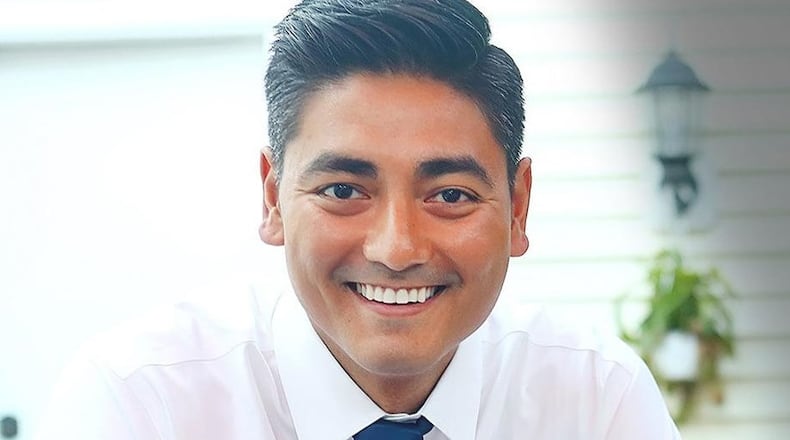His political aspirations started early, with Pureval serving as class president at Beavercreek High School, and student body president as an undergraduate at Ohio State University.
In a Dayton Daily News story, published on Page A1 on Nov. 19, 2000, Pureval told reporter Mara Lee about his political vision.
An excerpt from the story:
Aftab Pureval wants to be the president of the United States. His father has his doubts.
Aftab won his first election in eighth grade with the slogan “Big, Brown and Beautiful.” It’s an apt description of the Beavercreek High School senior.
He has his mother’s Tibetan cheekbones, his father’s dark Indian skin, and almond-shaped eyes that reveal his multi-ethnic lineage. He’s 6-foot-3 and his sassy smile is all-American, confident as a boy from a happy childhood on a cozy Ohio cul-de-sac has every right to be.
But Aftab’s campaign for senior class president hints at potential problems for his political future. Aftab was running against another boy named Greene. His campaign manager came up with the slogan: “Simple Math: Brown > Greene.” He also had posters saying: “Aftab isn’t your average Joe.” His opponent countered: “Vote for the American candidate.”
“At first I was shocked,” Aftab said. “These were my friends, you know.”
But when he thought about it more, he said, “I knew I was going to win anyway. It was my pride that was hurt, really.”
The slogan miscasts the changing face of our country’s youth population. And its implication that U.S.-born children of immigrants are still foreigners is one reason Aftab’s father doesn’t think we’re ready for a Pureval presidency, even 25 years from now.
The story looked at immigrants and the children of immigrants, and how those children often struggle with their own identity and with the ignorance of their peers.
Another excerpt said:
High schools, where kids from all backgrounds are thrown together, often show the country’s demographic changes in miniature.
At the Beavercreek vs. Carroll football game this fall, teens played out their typical interaction: Kids compared class schedules and caught up on relationships, asking who broke up and are they getting back together. Occasionally, they stopped to watch what was happening on the field.
Standing in the bleachers, Aftab chatted with his friends. His race, and in fact, the question of race in general, came up repeatedly.
“There are only 25 African-Americans (at Beavercreek High),” Aftab said. “Half are on the field. “There’s a lot more Asians. The freshman class has a lot of Asians, actually.”
Beavercreek has 101 Asian-American students among a student body of almost 2,200.
Shaun Fox came up and embraced Aftab. “Aftab! My twin!”
Other students say Shaun and Aftab look alike, and often confuse them. Shaun has the same almond-shaped eyes as Aftab, and is almost as tall. But beyond that and a similar haircut, they share little resemblance.
“This is my favorite Asian buddy,” Aftab said. “He’s only half Asian.”
“I look Mexican for some reason,” Shaun offered. A classmate teased Aftab that he won’t go to his house after the game, because it smells bad.
Aftab explained that he’s talking about Indian food. He said his soccer coach even teases him about this.
“If you had some curry, you’d get over to the ball faster,” Aftab said his coach says. Aftab teases his Italian-American coach right back. “Bring me over some pasta and maybe I will.”
Behind Aftab and his friends, a group of rowdy boys put a noose around the neck of an effigy of Carroll’s mascot, a patriot the size of a large doll. They tossed the effigy over the goal post.
For Aftab, the scene evoked racial lynchings, a tasteless display.
“That’s kinda crazy,” Aftab said. He yelled to the guys, “They used to do that in the South, people!”
Aftab and his classmates’ sensitivity to race and ethnicity illustrates a national debate about the impact of immigration, scholars say. Suarez-Orosco said there are two schools of thought. One is that the Asian and Hispanic immigrants at the end of the 20th century and the beginning of the 21st will, through intermarriage and the loss of their native languages, become as assimilated in a melting pot as Europeans did a century before them.
The other view is that they will be less digestible because there’s a steady stream of immigrants and because they’re darker-skinned than the Europeans.
“How we deal with the question of race will determine if America becomes a truly multiracial democracy,’’ said Ling-Chi Wang, head of the Asian-American Studies department at University of California-Berkeley.
In the story, Pureval talked about never feeling out of place.
Many of the Asian-American and Middle Eastern teens said they hardly noticed differences between themselves and their classmates growing up, and emphasized their similarity to their peers.
The Rattan family has lived next to Aftab Pureval’s family in Beavercreek for most of their sons’ lives. Amit Rattan, 17, is Sikh, and follows the tradition of never cutting his hair. He wears it in a bun on top of his head, covered by a cloth.
“I never felt out of place or an outcast,” Amit said. “I had a lot of friends. That difference wasn’t a bad thing.”
But his mother Tejinder Rattan, sitting across the room, remembered the insults, “Towel head” and “Aladdin,” hurled from the opposing sidelines during her son’s soccer games when he was in elementary school.
Reminded of the heckling, Amit said, “I’ve learned to ignore it. It’s been with me my whole life. It doesn’t hurt me anymore.”
Amit’s older brother Mantosh had a harder time, coming when there were fewer Sikhs in the area, Amit said.
He cut his hair in kindergarten to fit in, then let it grow again until his teen years. When he went out for football, they said he couldn’t play with the turban. So he cut his hair again.
For Amit, Beavercreek High ordered a custom-fit helmet.
Aftab, too, downplayed his difference. “I never have in the back of my mind that I’m a minority. All my life I’ve been around different races,” he said. “I never thought of myself as different from anyone else.”
Mark Langenderfer grew up on the same cul-de-sac with Aftab and Amit until his father was sent to Mississippi with the Air Force. The family returned when Mark was in the ninth grade. He’s become so accustomed to diversity that he’s considering rejecting some colleges because they are “too white.”
Aftab’s popularity transcends race, Mark said.
“At the school, Aftab’s accepted by everybody. He’s just one of the crowd.”
About the Author

